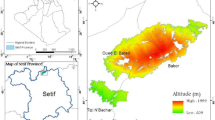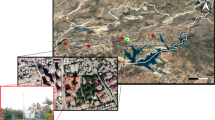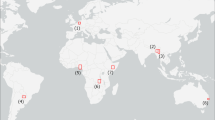Abstract
In present study soil radon (Rn-222) emanation, geomagnetic total field intensity (Btotal), and total electron content (TEC) in ionosphere prior to Mw 5.5, Kokrajhar, Assam earthquake of September 12, 2018 were investigated using multiparametric geophysical observations at Ouguri Hills, Tezpur, Assam. Prominent anomalies were observed in the soil Rn-222 emanation, Btotal and TEC time series prior to the event and are discussed. It was observed that soil Rn-222 persisted anomalies 50 days prior to the earthquake event. The correlation coefficient between soil Rn-222 with soil temperature and soil pressure was estimated to be feeble, 0.2 and –0.4 during the investigation period. Similar anomalies were observed 26 days prior to the earthquake event in Btotal. The ionospheric TEC also persisted anomalies 17 days prior to the event. The amount of anomalous values observed for soil Rn-222, Btotal, and ionospheric TEC ranged between –15.61 to 25.02 KBq/m3, –83.33 to 10.50 nT and –13.06 to 7.09 TECU below LB and above UB respectively. An increase of 1.92 nT and a decrease of –36.77 nT of daily rate change was observed during the anomaly period compared to the normal days. The study revealed possibility of precursor detection through multi parametric approach from ground to ionosphere level.









Similar content being viewed by others
REFERENCES
J. Angelier and S. Baruah, “Seismotectonics in Northeast India: A stress analysis of focal mechanism solutions of earthquakes and its kinematic implications,” Geophys. J. Int. 178, 303‒326 (2009).
F. Arikan, H. Nayir, U. Sezen, and O. Arikan, “Estimation of single station interfrequency receiver bias using GPS-TEC,” Radio Sci. 43 (2008). https://doi.org/10.1029/2007RS003785
Santanu Baruah, Saurabh Baruah, P. Bora, R. Duarah, A. Kalita, R. Biswas, and J. Kayal, “Moment magnitude (Mw) and local magnitude (ML) relationship for earthquakes in Northeast India,” Pure Appl. Geophys. 169, 1977‒1988, (2012).
V. G. Bakhmutov and A. A. Groza, “The dilatancy-diffusion model: New prospects,” In Proceedings of the 7th International Conference “Problems of Geocosmos,” St. Petersburg, Russia, 2008 (2008), pp. 406–411.
N. Bhargava, V. Katiyar, M. Sharma, and P. Pradhan, “Earthquake prediction through animal behavior: A review,” Indian J. Biomech. 78, 159‒165 (2009).
P. M. Bhattacharya, S. Mukhopadhyay, R. Majumdar, and J. Kayal, “3D seismic structure of the northeast India region and its implications for local and regional tectonics,” J. Asian Earth Sci. 33, 25‒41 (2008).
P. M. Bhattacharya, J. Kayal, S. Baruah, and S. Arefiev, “Earthquake source zones in northeast India: Seismic tomography, fractal dimension and b value mapping,” Pure Appl. Geophys. 167, 999–1012 (2010).
Criteria for Earthquake Resistant Design of Structures (Bureau of Indian Standards, New Delhi, 2002), Pt. 1.
S. Chapman and J. Bartels, Geomagnetism, Vol. II: Analysis of the Data, and Physical Theories (Oxford Univ. Press, Oxford, 1940).
T. Chetia, Saruabh Baruah, C. Dey, S. Sharma, and Santanu Baruah, “Probabilistic analysis of seismic data for earthquake forecast in North East India and its vicinity,” Current Sci. 117, 1167–1173 (2019).
J. R. Curray, F. J. Emmel, D. G. Moore, and R. W. Raitt, “Structure, tectonics, and geological history of the northeastern Indian Ocean,” in The Indian Ocean, Vol. 6 of The Ocean Basins and Margins, Ed. by A. E. M. Nairn and F. G. Stehli (Springer, New York, 1982) pp. 399‒450.
T. Diehl, J. Singer, G. Hetényi, D. Grujic, J. Clinton, D. Giardini, and E. Kissling, and GANSSER Working Group, “Seismotectonics of Bhutan: Evidence for segmentation of the Eastern Himalayas and link to foreland deformation,” Earth Planet. Sci. Lett. 471, 54‒64 (2017).
I. Dobrovolsky, N. I. Gershenzon, and M. B. Gokhberg, “Theory of electrokinetic effects occurring at the final stage in the preparation of a tectonic earthquake,” Phys. Earth Planet. Inter. 57, 144‒156 (1989).
B. Gutenberg, “The energy of earthquakes,” Q. J. Geol. Soc. London 112, 1–14 (1956).
G. Immè and D. Morelli, “Radon as earthquake precursor,” in Earthquake Research and Analysis: Statistical Studies, Observations and Planning, Ed. by S. D’Amico (Intech Open, 2012), pp. 143–160. https://doi.org/10.5772/29917
J. R. Kayal, S. S. Arefiev, S. Barua, D. Hazarika, N. Gogoi, A. Kumar, S. N. Chowdhury, and S. Kalita, “Shillong plateau earthquakes in northeast India region: Complex tectonic model,” Current Sci. 91, 109–114 (2006).
J. R. Kayal, Microearthquake Seismology and Seismotectonics of South Asia (Springer, 2008).
J. Kayal, S. S. Arefiev, S. Baruah, R. Tatevossian, N. Gogoi, M. Sanoujam, and D. Borah, “The 2009 Bhutan and Assam felt earthquakes (Mw 6.3 and 5.1) at the Kopili fault in the northeast Himalaya region,” Geomatics, Nat. Hazards Risk 1, 273‒281 (2010).
J. Kayal, S. Arefiev, S. Baruah, D. Hazarika, N. Gogoi, J. Gautam, and R. Tatevossian, “Large and great earthquakes in the Shillong plateau–Assam valley area of Northeast India Region: Pop-up and transverse tectonics,” Tectonophysics 532, 186‒192, (2012).
L. Kersley, D. Malan, S. E. Pryse, L. R. Cander, R. A. Bamford, A. Belehaki, R. Leitinger, S. M. Radicella, C. N. Mitchell, and P. S. J. Spencer, “Total electron content - A key parameter in propagation: Measurement and use in ionospheric imaging,” Ann. Geofis. 47 (Suppl. to Nos. 2–3), 1067–1091 (2004).
K. Khattri, M. Wyss, V. Gaur, S. Saha, and V. Bansal, “Local seismic activity in the region of the Assam gap, northeast India,” Seismol. Soc. Am. Bull. 73, 459‒469 (1983).
F. Kulali, İ. Akkurt, N. Özgür, and M. Sezer, “The correlation of the seismic activities and radon concentration in soil gas,” Arab. J. Geosci. 11, 447 (2018).
A. Kumar, V. Walia, S. Singh, B. S. Bajwa, S. Mahajan, S. Dhar, and T. F. Yang, “Earthquake precursory studies at Amritsar Punjab, India, using radon measurement techniques,” Int. J. Phys. Sci. 7, 5669‒5677 (2012).
Y. I. Lambert, A. McKay, and Y. Miezitis, Australia’s Uranium Resources: Trends, Global Comparisons and New Developments (Bur. Resour. Sci., Canberra, 1996).
G. Ma and T. Maruyama, “Derivation of TEC and estimation of instrumental biases from GEONET in Japan,” Ann. Geophys. 21, 2083–2093 (2003).
D. Nandy and S. Dasgupta, “Seismotectonic domains of northeastern India and adjacent areas,” Phys. Chem. Earth 18, 371‒384 (1991).
D. Nandy, Geodynamics of North Eastern India and the Adjoining Region (ACB Publ., Kolkata, 2001).
J. Ni and, M. Barazangi, “Seismotectonics of the Himalayan collision zone: Geometry of the underthrusting Indian plate beneath the Himalaya,” J. Geophys. Res. B 89, 1147‒1163 (1984).
R. Oldham, “On a plant of Glossopteris with part of the rhizome attached, and on the structure of Vartebrari,” Rec. Geol. Surv. India 30, 45‒50 (1897).
D. Ouzounov, S. Pulinets, K. Hattori, M. Parrot, J. Y. Liu, T. F. Yang, A. Rellano-Baeza, M. Kafatos, and P. Taylor, “Validation of atmosphere/ionosphere signals associated with major earthquakes by multi-instrument space-borne and ground observations,” IEEE International Geosciences and Remote Sensing Symposium “Remote Sensing for a Dynamic Earth,”Munich, Germany, 2012 (2012).
V. Pham and R. J. Geller, “Comment on “Signature of pending earthquake from electromagnetic anomalies,” by K. Eftaxias et al., Geophys. Res. Lett. 29 (18), 18-1‒18-2 (2002).
J. Planinić, V. Radolić, and Ž. Lazanin, “Temporal variations of radon in soil related to earthquakes,” Appl. Radiat. Isot. 55, 267‒272 (2001).
M. Poddar, “The Assam earthquake of 15th August 1950,” Indian Mineral. 4, 167‒176 (1950).
S. Pulinets, K. Boyarchuk, V. Hegai, V. Kim, and A. Lomonosov, “Quasielectrostatic model of atmosphere-thermosphere-ionosphere coupling,” Adv. Space Res. 26, 1209‒1218 (2000).
S. Pulinets, A. L. Contreras, G. Bisiacchi-Giraldi, and L. Ciraolo, “Total electron content variations in the ionosphere before the Colima, Mexico, earthquake of 21 January 2003,” Geofis. Int. 44, 369‒377 (2005).
S. Pulinets, “Lithosphere-atmosphere-ionosphere coupling (LAIC) model,” in Electromagnetic Phenomena Associated with Earthquakes, Ed. by M. Hayakawa (Research Signpost, India, 2009), pp. 235‒253.
S. Pulinets and D. Ouzounov, “Lithosphere–Atmosphere–Ionosphere Coupling (LAIC) model – An unified concept for earthquake precursors validation,” J. Asian Earth Sci. 41, 371‒382 (2011).
C. Richter, “Transversely aligned seismicity and concealed structures,” Science 166, 173‒178 (1969).
P. Richon, J.-C. Sabroux, M. Halbwachs, J. Vandemeulebrouck, N. Poussielgue, J. Tabbagh, and R. Punongbayan, “Radon anomaly in the soil of Taal volcano, the Philippines: A likely precursor of the M 7.1 Mindoro earthquake (1994),” Geophys. Res. Lett. 30 (2003). https://doi.org/10.1029/2003GL016902
E. Rogozhin, A. Lutikov, and Tuo Shen, “Tectonic position and geological and seismic manifestations of the Gorkha earthquake of April 25, 2015, in Nepal,” Geotectonics 50, 522‒533 (2016).
E. Sardon, A. Rius, and N. Zarraoa, “Estimation of the transmitter and receiver differential biases and the ionospheric total electron content from Global Positioning System observations,” Radio Sci. 29, 577‒586 (1994).
E. Sardón and N. Zarraoa, “Estimation of total electron content using GPS data: How stable are the differential satellite and receiver instrumental biases?,” Radio Sci. 32, 1899‒1910 (1997).
C. H. Scholz, L. R. Sykes, and Y. P. Agarwal, “Earthquake prediction: A physical basis,” Science 181, 803‒810 (1973).
G. Seemala and C. Valladares, “Statistics of total electron content depletions observed over the South American continent for the year 2008,” Radio Sci. 46, (2011).
R. P. Singh, W. Mehdi, R. Gautam, J. S. Kumar, J. Zlotnicki, and M. Kafatos, “Precursory signals using satellite and ground data associated with the Wenchuan Earthquake of 12 May 2008,” Int. J. Remote Sens. 31, 3341‒3354 (2010).
J. R. Taylor, An Introduction to Error Analysis: The Study of Uncertainties in Physical Measurements, 2nd ed. (Univ. Sci. Books, Sausalito, Calif., 1997).
E. Tillotson, “The great Assam earthquake of August 15, 1950,” Nature 167, 128–130 (1951).
A. Tomer, “Radon as a earthquake precursor: A review,” Int. J. Sci. Eng. Technol. 4, 815‒822 (2016).
C. Valladares, J. Villalobos, M. Hei, R. Sheehan, S. Basu, E. McKenzie, and V. Rios, “Simultaneous observation of traveling ionospheric disturbances in the Northern and Southern Hemispheres,” Ann. Geophys. 27, 1501‒1508 (2009).
Book of Abstracts of the International Symposium on Uranium Raw Material for the Nuclear Fuel Cycle: Exploration, Mining, Production, Supply and Demand, Economics and Environmental Issues (URAM-2014), Vienna, Austria, 2014 (IAEA, 2014).
ACKNOWLEDGMENTS
The authors acknowledge Dr. Saurabh Baruah, Chief Scientist, CSIR-NEIST, P.I. (MPGO, Tezpur, Assam) for his constant support and guidance. The authors are thankful to Ministry of Earth Sciences (MoES) and Department of Science and Technology (DST), Government of India for providing funds vide project no. MoES/P.O.(Seismo)/NPEP-16/2011 to CSIR-North East Institute of Technology, Geoscience Division, Jorhat, Assam-785006. The authors also thank the anonymous reviewers for their helpful suggestions and comments.
Author information
Authors and Affiliations
Corresponding author
Additional information
The article is published in the original.
Rights and permissions
About this article
Cite this article
Chetia, T., Sharma, G., Dey, C. et al. Multi-Parametric Approach for Earthquake Precursor Detection in Assam Valley (Eastern Himalaya, India) using Satellite and Ground Observation Data. Geotecton. 54, 83–96 (2020). https://doi.org/10.1134/S0016852120010045
Received:
Revised:
Accepted:
Published:
Issue Date:
DOI: https://doi.org/10.1134/S0016852120010045




